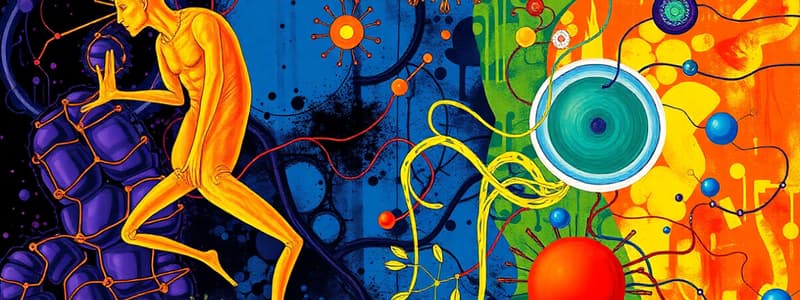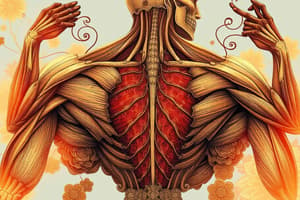Podcast
Questions and Answers
Why is the movement of a cat running distinct from the movement of a seedling growing?
Why is the movement of a cat running distinct from the movement of a seedling growing?
- The cat's movement is not directly related to growth, while the seedling's movement is. (correct)
- The cat's movement is faster and more obvious than the seedling's movement.
- The cat's movement is a response to external stimuli, while the seedling's movement is primarily internal.
- The cat's movement is controlled by a more complex nervous system.
How does the concept of 'response to the environment' relate to the idea of life?
How does the concept of 'response to the environment' relate to the idea of life?
- Living organisms intentionally modify their environment to suit their needs.
- All living organisms are capable of reacting to changes in their surroundings.
- Responding to the environment is a necessary, but not sufficient, condition for life.
- The ability to respond to environmental changes is a defining characteristic of life. (correct)
What is the significance of the statement that 'controlled movement must be connected to the recognition of various events in the environment'?
What is the significance of the statement that 'controlled movement must be connected to the recognition of various events in the environment'?
- It emphasizes the importance of a complex nervous system for coordinated movement.
- It implies that all movement in living organisms is purposeful and intentional.
- It highlights the link between sensory perception and appropriate motor responses. (correct)
- It suggests that living organisms have a conscious awareness of their surroundings.
What is the primary function of specialized tissues in multicellular organisms for control and coordination?
What is the primary function of specialized tissues in multicellular organisms for control and coordination?
Considering the example of whispering in class, what does this illustrate about control and coordination in living organisms?
Considering the example of whispering in class, what does this illustrate about control and coordination in living organisms?
How is the concept of 'appropriate movement in response' different from the concept of 'random movement'?
How is the concept of 'appropriate movement in response' different from the concept of 'random movement'?
What is the significance of the statement that 'living organisms must use systems providing control and coordination'?
What is the significance of the statement that 'living organisms must use systems providing control and coordination'?
Based on the text, which of these best describes the difference between a reflex action and walking?
Based on the text, which of these best describes the difference between a reflex action and walking?
Which of the following correctly describes the role of the 'thinking tissue' in the brain?
Which of the following correctly describes the role of the 'thinking tissue' in the brain?
What is a significant difference between thoughtful actions and reflex actions?
What is a significant difference between thoughtful actions and reflex actions?
What is the primary function of the synapse between two neurons?
What is the primary function of the synapse between two neurons?
Based on the provided text, which of these situations would most likely involve a reflex arc?
Based on the provided text, which of these situations would most likely involve a reflex arc?
Which of the following statements accurately describes the role of the cerebellum in human body functions?
Which of the following statements accurately describes the role of the cerebellum in human body functions?
The text describes how we detect the smell of an agarbatti (incense stick). Which of these processes is involved in this specific sensory experience?
The text describes how we detect the smell of an agarbatti (incense stick). Which of these processes is involved in this specific sensory experience?
The text states that 'reflex arcs have evolved in animals because the thinking process of the brain is not fast enough'. What does this statement imply about the evolution of the nervous system?
The text states that 'reflex arcs have evolved in animals because the thinking process of the brain is not fast enough'. What does this statement imply about the evolution of the nervous system?
Why is it crucial for a reflex arc to be located in the spinal cord rather than solely in the brain?
Why is it crucial for a reflex arc to be located in the spinal cord rather than solely in the brain?
What is the role of the brain in a reflex action?
What is the role of the brain in a reflex action?
Which of these best illustrates the concept of an involuntary action, as described in the text?
Which of these best illustrates the concept of an involuntary action, as described in the text?
Based on the information provided, how does an electrical impulse in a neuron become a chemical signal for further transmission?
Based on the information provided, how does an electrical impulse in a neuron become a chemical signal for further transmission?
If someone were to touch a hot object, why would pulling their hand back be considered a reflex action?
If someone were to touch a hot object, why would pulling their hand back be considered a reflex action?
Which part of the brain controls involuntary actions like blood pressure, salivation, and vomiting?
Which part of the brain controls involuntary actions like blood pressure, salivation, and vomiting?
Based on the text, which of these would be MOST likely to be affected if someone sustained damage to their cerebellum?
Based on the text, which of these would be MOST likely to be affected if someone sustained damage to their cerebellum?
Which of the following scenarios best exemplifies the concept of the 'thinking tissue' as described in the text?
Which of the following scenarios best exemplifies the concept of the 'thinking tissue' as described in the text?
How does the structure of the reflex arc contribute to its efficiency?
How does the structure of the reflex arc contribute to its efficiency?
The text describes how the brain is protected. Which of these is NOT mentioned as a method of protecting the brain?
The text describes how the brain is protected. Which of these is NOT mentioned as a method of protecting the brain?
What is the primary way muscles cause movement at the cellular level?
What is the primary way muscles cause movement at the cellular level?
Which of the following statements accurately describes the difference between the two types of plant movement discussed in the text?
Which of the following statements accurately describes the difference between the two types of plant movement discussed in the text?
What is the primary mechanism by which a sensitive plant moves its leaves in response to touch?
What is the primary mechanism by which a sensitive plant moves its leaves in response to touch?
Why is the growth of pea plant tendrils around a support considered an example of movement dependent on growth?
Why is the growth of pea plant tendrils around a support considered an example of movement dependent on growth?
What is the significance of the directional growth of roots downward and shoots upward in plants?
What is the significance of the directional growth of roots downward and shoots upward in plants?
What is the central idea behind the text's explanation of how information is communicated in multicellular organisms?
What is the central idea behind the text's explanation of how information is communicated in multicellular organisms?
How do plants and animals differ in their mechanisms for communication between cells?
How do plants and animals differ in their mechanisms for communication between cells?
What is the most likely reason why the movement of sunflowers towards the sun is slower than the movement of the sensitive plant?
What is the most likely reason why the movement of sunflowers towards the sun is slower than the movement of the sensitive plant?
Based on the information provided, what would 'hydrotropism' likely refer to?
Based on the information provided, what would 'hydrotropism' likely refer to?
What conclusion can be drawn from the activity described in Figure 6.5?
What conclusion can be drawn from the activity described in Figure 6.5?
Which of the following best explains why chemical communication is a more suitable strategy for coordinating activities in multicellular organisms compared to electrical impulses?
Which of the following best explains why chemical communication is a more suitable strategy for coordinating activities in multicellular organisms compared to electrical impulses?
Why is the movement of a plant's shoot towards light different from the movement of a sensitive plant's leaves?
Why is the movement of a plant's shoot towards light different from the movement of a sensitive plant's leaves?
Which of these is NOT a direct effect of adrenaline secretion in a squirrel preparing for a threat?
Which of these is NOT a direct effect of adrenaline secretion in a squirrel preparing for a threat?
Why would a diet deficient in iodine potentially lead to goitre, a condition characterized by a swollen neck?
Why would a diet deficient in iodine potentially lead to goitre, a condition characterized by a swollen neck?
Which hormone is responsible for regulating blood sugar levels, and what happens when its production is insufficient?
Which hormone is responsible for regulating blood sugar levels, and what happens when its production is insufficient?
How do plant hormones differ from animal hormones in terms of their overall role in growth and development?
How do plant hormones differ from animal hormones in terms of their overall role in growth and development?
Flashcards
Life processes
Life processes
Functions essential for maintaining life in organisms.
Growth movement
Growth movement
Movement resulting from the growth of a living organism, like a plant pushing through soil.
Environmental response
Environmental response
Movement triggered by changes in the surroundings, like animals reacting to stimuli.
Controlled movement
Controlled movement
Signup and view all the flashcards
Nervous system
Nervous system
Signup and view all the flashcards
Specialised tissues
Specialised tissues
Signup and view all the flashcards
Muscular system
Muscular system
Signup and view all the flashcards
Sensory Receptors
Sensory Receptors
Signup and view all the flashcards
Nervous Impulse
Nervous Impulse
Signup and view all the flashcards
Synapse
Synapse
Signup and view all the flashcards
Reflex Arc
Reflex Arc
Signup and view all the flashcards
Spinal Cord
Spinal Cord
Signup and view all the flashcards
Central Nervous System
Central Nervous System
Signup and view all the flashcards
Gustatory Receptors
Gustatory Receptors
Signup and view all the flashcards
Olfactory Receptors
Olfactory Receptors
Signup and view all the flashcards
Chemical Signal
Chemical Signal
Signup and view all the flashcards
Voluntary actions
Voluntary actions
Signup and view all the flashcards
Peripheral nervous system
Peripheral nervous system
Signup and view all the flashcards
Fore-brain
Fore-brain
Signup and view all the flashcards
Reflex action
Reflex action
Signup and view all the flashcards
Cerebellum
Cerebellum
Signup and view all the flashcards
Medulla
Medulla
Signup and view all the flashcards
Sensory impulses
Sensory impulses
Signup and view all the flashcards
Motor areas of the brain
Motor areas of the brain
Signup and view all the flashcards
Nerve impulse
Nerve impulse
Signup and view all the flashcards
Involuntary actions
Involuntary actions
Signup and view all the flashcards
Auxins
Auxins
Signup and view all the flashcards
Gibberellins
Gibberellins
Signup and view all the flashcards
Adrenaline
Adrenaline
Signup and view all the flashcards
Thyroxin
Thyroxin
Signup and view all the flashcards
Growth Hormone
Growth Hormone
Signup and view all the flashcards
Immediate Response
Immediate Response
Signup and view all the flashcards
Electrical-Chemical Communication
Electrical-Chemical Communication
Signup and view all the flashcards
Tropic Movements
Tropic Movements
Signup and view all the flashcards
Phototropism
Phototropism
Signup and view all the flashcards
Geotropism
Geotropism
Signup and view all the flashcards
Hydrotropism
Hydrotropism
Signup and view all the flashcards
Chemotropism
Chemotropism
Signup and view all the flashcards
Cells Change Shape
Cells Change Shape
Signup and view all the flashcards
Slow vs Fast Movements
Slow vs Fast Movements
Signup and view all the flashcards
Hormones in Plants
Hormones in Plants
Signup and view all the flashcards
Study Notes
Control and Coordination in Living Organisms
- Living organisms respond to environmental changes via movement.
- Movement in plants can be due to growth (e.g., seedling pushing soil).
- Movement in animals and some plants doesn't involve growth (e.g., running cat).
- Movement is a response to environmental change and utilized for organisms' benefit.
Animal Nervous System
- Animals use nervous and muscular tissues for control and coordination.
- Nerve cells (neurons) detect environmental changes.
- Receptors in sense organs (e.g., ears, nose) detect information.
- Information is converted to electrical impulses.
- Impulses travel through dendrites, cell bodies, and axons.
- Impulses become chemical signals at synapses.
- Signals pass to other cells like muscles/glands.
- Nervous tissue is a network of neurons for transmitting information.
- Information is acquired by specialized tips of nerve cells (receptors).
- Electrical impulses travel through axons.
- Chemical signals transmit impulses at synapses.
Reflex Actions
- Reflex actions are rapid responses without conscious thought.
- Reflex arcs connect sensory nerves to motor nerves directly in the spinal cord.
- Reflex arcs are faster than conscious thought-based responses.
- Reflex arcs evolved as a quicker function in animals lacking complex thought processes.
- Information from input nerve travels to the brain (spinal cord acts as a relay).
- Reflexes are faster than thinking responses and thus advantageous.
Human Brain
- The brain and spinal cord are the central nervous system.
- The brain receives info from body parts and integrates responses.
- Voluntary actions are driven by conscious decisions (e.g., talking, writing).
- Voluntary actions involve the brain sending messages to muscles.
- The peripheral nervous system transmits messages between central and other body parts.
- The brain has three major regions: forebrain, midbrain, and hindbrain.
- Forebrain (major thinking part), receives sensory input, interprets information, and controls voluntary muscles.
- Forebrain includes centers for sensations like hunger.
- Midbrain and Hindbrain regulate involuntary actions (e.g., heartbeat, breathing).
- Medulla in hindbrain controls blood pressure, salivation, and vomiting.
- Cerebellum in hindbrain controls voluntary actions' precision, posture, and balance.
Protection of Nervous Tissues
- The brain is situated in a bony skull for protection.
- Fluid-filled compartments surround the brain for further protection.
- The spinal cord is protected by the vertebral column.
Muscle Movement
- Muscle cells shorten by changing shape in response to nerve impulses.
- Muscles are composed of special proteins which change arrangement.
- Muscles change their shape/arrangement in response to electrical stimuli.
Plant Control & Coordination
- Plants lack a nervous system and muscles.
- Plant movements can be growth-dependent or independent.
- The sensitive plant exhibits quick, non-growth-based leaf movement. Detection and response methods are different from animals.
- Electrical-chemical communication occurs in plants for information transmission.
- Plant cells change shape by changing water content.
- Tendrils climb via differential growth rates.
Plant Tropisms
- Directional plant movements are called tropisms.
- Phototropism: Shoots grow toward light, roots away.
- Geotropism: Shoots grow upward, roots downward (gravity).
- Hydrotropism: Growth towards water.
- Chemotropism: Growth towards chemicals (e.g., pollen tubes to ovules).
Chemical Coordination in Animals (Hormonal System)
- Animals use hormones for widespread communication.
- Adrenaline is released in stressful situations and increases heart rate and blood flow to muscles.
- Endocrine system (glands secreting hormones) provides chemical coordination.
Plant Hormones
- Plant hormones control growth, development, and responses to stimuli.
- Auxins promote cell elongation, particularly on the shaded side of a plant.
- Gibberellins contribute to stem growth.
- Cytokinins stimulate cell division.
- Abscisic acid inhibits growth and causes leaf wilting.
Hormonal Regulation in Animals
- Precise hormone secretion is regulated by feedback mechanisms.
- Thyroid hormone's production needs iodine (importance of iodized salt).
- Growth hormone regulates growth and development.
- Puberty is associated with testosterone (male) and estrogen (female) production.
- Insulin regulates blood sugar levels in diabetes.
- Hypothalamus plays a role in regulating hormone release (i.e. growth hormone).
Activity
- Activities are described; instructions and questions are related to experiments and observations.
Summary
- Nervous and hormonal systems control and coordinate organism functions.
- The nervous system uses electrical impulses.
- Chemical coordination (hormones) is widespread in both plants and animals.
- Feedback mechanisms regulate hormone levels.
Studying That Suits You
Use AI to generate personalized quizzes and flashcards to suit your learning preferences.




